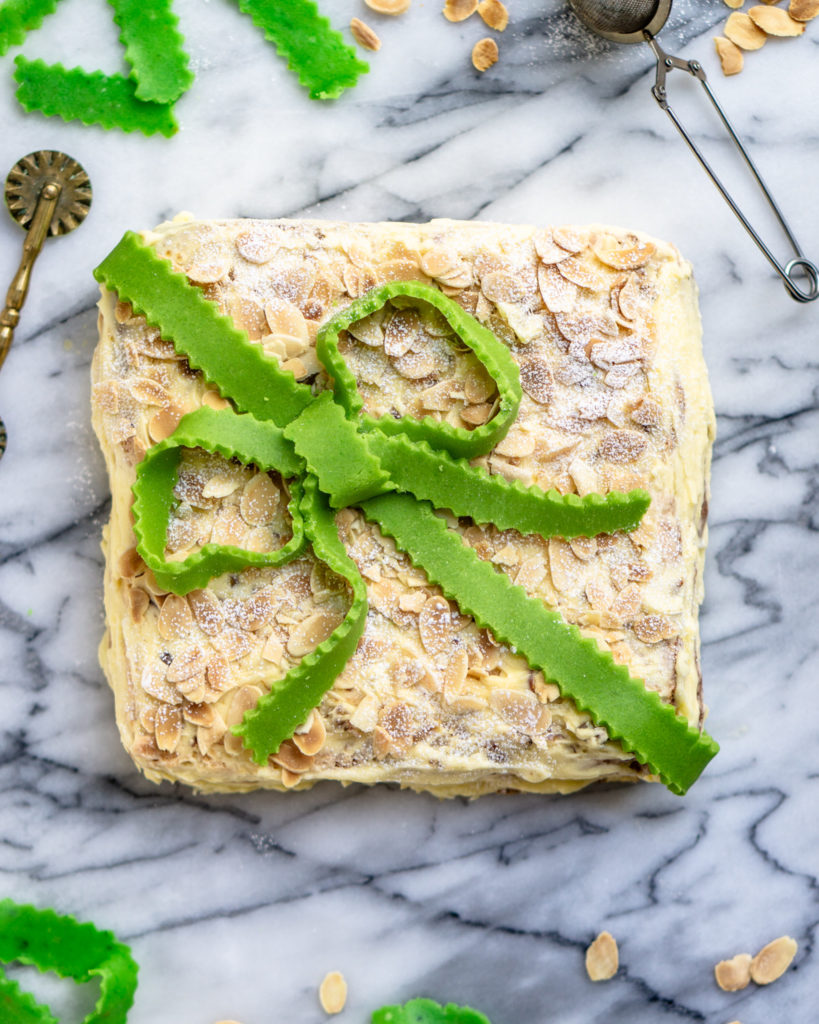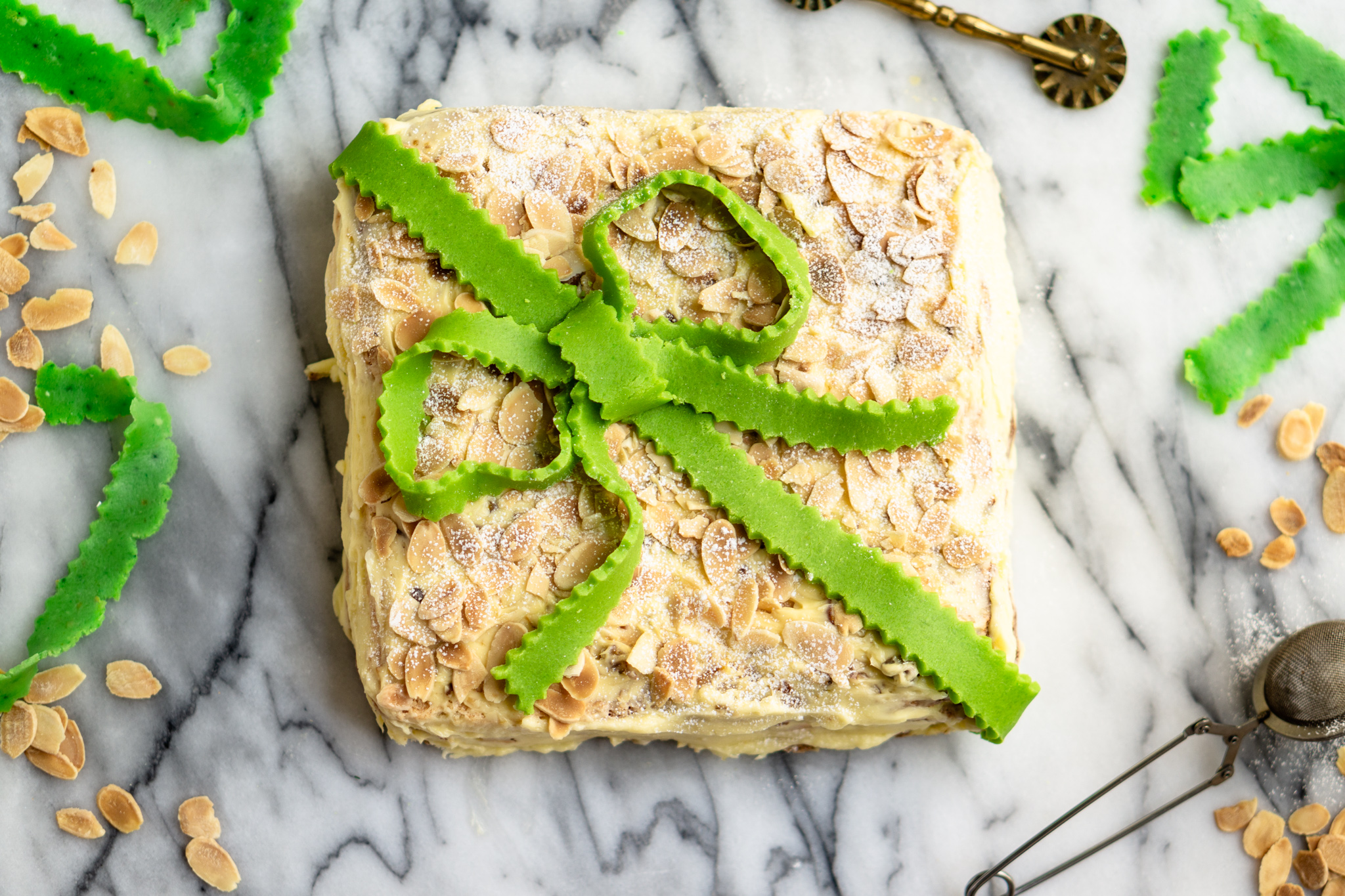Sans rival means unrivaled. That’s a hard feat for a cake to live up to — but if one cake can do it, then maybe it is this one.
It even has a royal connection:
“At least once a year, the king gets a homebaked cake. It is a big, magnificent Sans Rival, which Taimi bakes for his birthday.”
Being the king’s cook comes with great responsibility. From the article in Svenska Dagbladet in 1976, it seems like Taimi Kivinen met the challenge with unfazed determination.
You probably need that when the number of guests for dinner changes from twelve to twenty-four. And now it is no longer a normal dinner but the king’s engagement dinner. And you hear about it at three o’clock on the same day.
When the interview was published, Carl XVI Gustaf had been the king of Sweden for three years and had recently married Silvia Sommerlath. The interview with self-taught Taimi Kivinen shares how the king is fond of simple dishes like raggmunkar, that the kitchen turns the palaces’ fruits into firm marmalade (the king doesn’t like the runny version, “and who does?” as the article says), and how the new queen tactfully hadn’t interfered with Kivinen’s choice of dishes.
Out of what sounds almost like maternal concern, Kivinen apparently wouldn’t offer the king much in terms of sweets or baked goods, but once a year, she would bake a Sans Rival cake for his birthday.
So, let’s take a look at this royal cake.

What is a Sans Rival cake?
Almond meringue layers spread with praline buttercream just won’t turn into a light dessert.
To maximize the royal-ness of this cake, I used the recipe from Prinsessornas kokbok. The princesses in the cookbook name were cousins of king Carl XVI Gustaf’s grandfather. In the cookbook, Sans Rival is referred to as “our best cake”.
Among my cookbooks, Sans Rival appears first in the 30s, in the previously mentioned Prinsessornas kokbok in 1934. My research didn’t turn up much regarding the history of the cake. Svenska Dagbladet’s archive shows that Sans Rival was a common name both for boats and horses, for the same reason — you want a winner. Whether the cake was named after a victor or just to beat other cakes remains a mystery.
Contemporary cookbooks are more likely to feature a similar cake called Oscar II (we’ll get there, but not today). While it contains a lot of butter, Oscar II’s filling features more eggs. Sans Rival also seems to be commonly served in a square or rectangular shape, while Oscar is round.

How to make a Swedish Sans Rival cake
After having attempted the buttercreams in Prinsessornas kokbok and in Sju sorters kakor, I just have to recommend the latter method instead. I gave up on my crystalizing sugar syrup after the third attempt, and there wasn’t a discernable taste difference. However, if you are making the cake for someone gluten-intolerant, use potato starch or corn starch instead to thicken the buttercream.
I know this cake looks like a lot, but while it is time-consuming, it isn’t overly complex. It is best to make this cake the day before it is supposed to be eaten — or at least several hours.
For the almond meringue layers
150 g (5 1/3 oz) almonds
200 g (7 oz) powdered sugar
5 egg whites
For the praline
50 g (1 2/3 oz) almonds
50 g (1 2/3 oz) sugar
For the buttercream
First part
2 1/2 dl (1 cup) water
2 tbsp butter
2 1/2 tbsp flour
5 yolks
Second part
300 g (1 1/3 cup) butter (room temperature)
1 1/2 dl powdered sugar
For decoration
150 g (5 1/3 oz) marzipan
green food-coloring
50 g (1 2/3 oz) almond flakes (or chop up whole almonds)
powdered sugar, for dusting (optional)
Method
The cake
- Set the oven to 175°C (345°F). You are making four layers so draw in total four squares, about 18x18cm (7×7 inches), on two baking papers. If you’re using see-through silicone baking sheets, you can place a paper square of the same size underneath and use it as an outline instead.
- Start by making the almond meringue layers by blanching the almonds and grinding them finely, preferably using a nut grinder or a mixer. You can also use store-bought almond flour instead.
- Whisk the five egg whites into a stiff foam. Sift the powdered sugar. Then add the icing sugar and the ground almonds to the egg whites. Stir them in, as gently as you can.
- Bake one sheet (two layers) at a time, in the center of the oven. Bake them for about 15 minutes, or until they are slightly golden. If they are underbaked, they won’t be very stable. As soon as they are out of the oven, remove the layers from the baking paper. You can do this by flipping them upside down on another baking paper and then peeling off the baking paper.
The almond praline
- Prepare a baking tray with a baking paper. Make the almond praline in a heavy-duty saucepan or frying pan (I use a cast-iron frying pan).
- Melt the sugar together with the almonds until the sugar caramelizes. Be careful so it won’t burn — and be careful not to burn yourself, either.
- Place the almond caramel on a baking sheet and leave them to cool.
The buttercream
- Heat the water and two tablespoons of butter in a saucepan until the butter melts.
- Add the flour to the buttery water and whisk until it thickens.
- Remove from the heat. If it got lumpy, press it through a sieve. Let it cool and then stir in the five yolks.
- Stir the butter together with the powdered sugar. Then stir in the yolk mixture.
- Chop up the almond praline — the original recipes suggests grinding it but I prefer a medium-coarse chop instead. Stir the praline into the buttercream.
Assembly
- Gently toast the almond flakes a few minutes — keep an eye on them, as they burn easily. Let them cool.
- When your almond meringue layers and almond flakes have cooled, it’s time to put your cake together. Take one layer and spread it with the buttercream. Place another layer on top and repeat. Then cover the sides with buttercream. Sprinkle the cake with almond flakes.
- Give the marzipan a mild green color (or experiment with something to your liking!). Roll it out with a rolling pin. This is easiest done on a baking paper or some plastic wrap. Then cut the marzipan into strips and decorate the cake. The traditional way is with a diagonal ribbon and a large “Rococo style” bow, but go for whatever takes your fancy. Pink roses are quite common, too.
- Cover and chill the cake and enjoy it the next day.



0 Comments